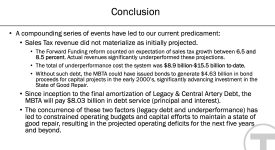lainpimicaja
Active Member
- Joined
- Jun 28, 2021
- Messages
- 165
- Reaction score
- 650
Posted this elsewhere but realizing it's better-suited here:
I found this report that was included in today's MBTA board meeting fascinating: https://cdn.mbta.com/sites/default/...A Jan 2024 TP VF 1.18.24VF posted 1.25.24.pdf
It's a history of funding at the MBTA, with an emphasis on the last twenty five years since Forward Funding and is by far the most succinct summary of Forward Funding, Big Dig-incurred debt, etc. I want a billboard of the conclusion slide on the SE Expressway:
I found this report that was included in today's MBTA board meeting fascinating: https://cdn.mbta.com/sites/default/...A Jan 2024 TP VF 1.18.24VF posted 1.25.24.pdf
It's a history of funding at the MBTA, with an emphasis on the last twenty five years since Forward Funding and is by far the most succinct summary of Forward Funding, Big Dig-incurred debt, etc. I want a billboard of the conclusion slide on the SE Expressway:



